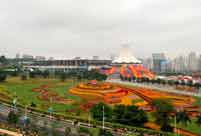After 27 years of fast economic growth and changing lifestyles, has the average Chinese man's waistline got bigger? A national survey is about to find the answer.
The China National Institute of Standardization is preparing for a national anthropometric survey to examine changes in the measurements of average Chinese since the last such survey in 1986, confirmed Zhao Chaoyi, director of the institute's anthropometry lab, in an interview with Xinhua on Monday.
The survey will take about five years, targeting Chinese citizens aged between 18 and 75 and sampling about 20,000 people in six sampling areas with a nationwide geographical spread.
Since the Chinese government approved the survey in June, the institute has been working on a detailed plan for the work and expects to start sampling in the latter half of 2014, Zhao said.
The institute did an anthropometric survey of a smaller scale on 3,000 sampled Chinese in 2009, when it found that the measurements of ordinary Chinese have changed a great deal since the last national survey.
According to the 2009 research, the average weight of Chinese aged above 35 had notably increased and the average waistline of an adult man had grown by 5 cm since 1986, said Zhang Xin, an assistant research fellow with the institute.
The updated research will help inform industrial designs from cars to smartphones.
"All current industrial designs are based on the figures in 1986, which are obviously outdated," Zhang said.
Besides recording people's basic measurements as the last survey did, researchers will also collect data on muscle strength, visual and hearing acuity, and fingertip tactility this time.
"Many new products have been invented and introduced into Chinese people's lives in the past three decades. The industry has demanded new data," Zhao noted.
For instance, data about fingertip tactility is very much needed since touch screens have become widely used in mobile phones and computers, the senior researcher said.
An increasing number of Chinese are driving cars so the auto industry needs data about muscle strength to adjust gas pedals.
"Accurate anthropometric data can make products user-friendly. We can import technologies and device from foreign countries, but it is Chinese who use them. Only domestic anthropometric data can help," Zhao said.
In the last survey in 1986, researchers worked with rulers and band tapes. This time they will apply 3D human body scanners.
Chinese researchers have been lobbying for anthropometric data to be updated as regularly as every five to 10 years.
 Mountain of garbage in Nairobi
Mountain of garbage in Nairobi Highlights of MAKS 2013 Int'l Aviation and Space Show
Highlights of MAKS 2013 Int'l Aviation and Space Show  10th China-ASEAN Expo opens in Nanning
10th China-ASEAN Expo opens in Nanning Eagle Boy takes to sky to break another record
Eagle Boy takes to sky to break another record 12-year-old boy becomes pillar of the family
12-year-old boy becomes pillar of the family Eye-gouged boy receives blind rehabilitation in Shanxi
Eye-gouged boy receives blind rehabilitation in Shanxi Top 10 naked hotels in the world
Top 10 naked hotels in the world The most gorgeous Chinese women in the eyes of foreigners
The most gorgeous Chinese women in the eyes of foreigners A collection of bizarre rooftop buildings around China
A collection of bizarre rooftop buildings around China Putin intimate contacts with marine animals
Putin intimate contacts with marine animals China's frigate 'Bengbu'in fire training
China's frigate 'Bengbu'in fire training Fresh students 'forced' to register in university independently
Fresh students 'forced' to register in university independently 2013 Taiwan Int'l Tourism Expo kicks off in Taipei
2013 Taiwan Int'l Tourism Expo kicks off in Taipei Photo story: Take a gap year
Photo story: Take a gap year Nokia's Global Headquarters: visiting a declining empire
Nokia's Global Headquarters: visiting a declining empireDay|Week|Month